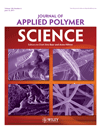Effect of pro-oxidants on biodegradation of polyethylene (LDPE) by indigenous fungal isolate, Aspergillus oryzae
Abstract
Proxidant additives represent a promising solution to the problem of the environment contamination with polyethylene film litter. Pro-oxidants accelerate photo- and thermo-oxidation and consequent polymer chain cleavage rendering the product apparently more susceptible to biodegradation. In the present study, fungal strain, Aspergillus oryzae isolated from HDPE film (buried in soil for 3 months) utilized abiotically treated polyethylene (LDPE) as a sole carbon source and degraded it. Treatment with pro-oxidant, manganese stearate followed by UV irradiation and incubation with A. oryzae resulted in maximum decrease in percentage of elongation and tensile strength by 62 and 51%, respectively, compared with other pro-oxidant treated LDPE films which showed 45% (titanium stearate), 40% (iron stearate), and 39% (cobalt stearate) decrease in tensile strength. Fourier transform infrared (FTIR) analysis of proxidant treated LDPE films revealed generation of more number of carbonyl and carboxylic groups (1630–1840 cm−1 and 1220–1340 cm−1) compared with UV treated film. When these films were incubated with A. oryzae for 3 months complete degradation of carbonyl and carboxylic groups was achieved. Scanning electron microscopy of untreated and treated LDPE films also revealed that polymer has undergone degradation after abiotic and biotic treatments. This concludes proxidant treatment before UV irradiation accelerated photo-oxidation of LDPE, caused functional groups to be generated in the polyethylene film and this resulted in biodegradation due to the consumption of carbonyl and carboxylic groups by A. oryzae which was evident by reduction in carbonyl peaks. Among the pro-oxidants, manganese stearate treatment caused maximum degradation of polyethylene. © 2011 Wiley Periodicals, Inc. J Appl Polym Sci, 2011




